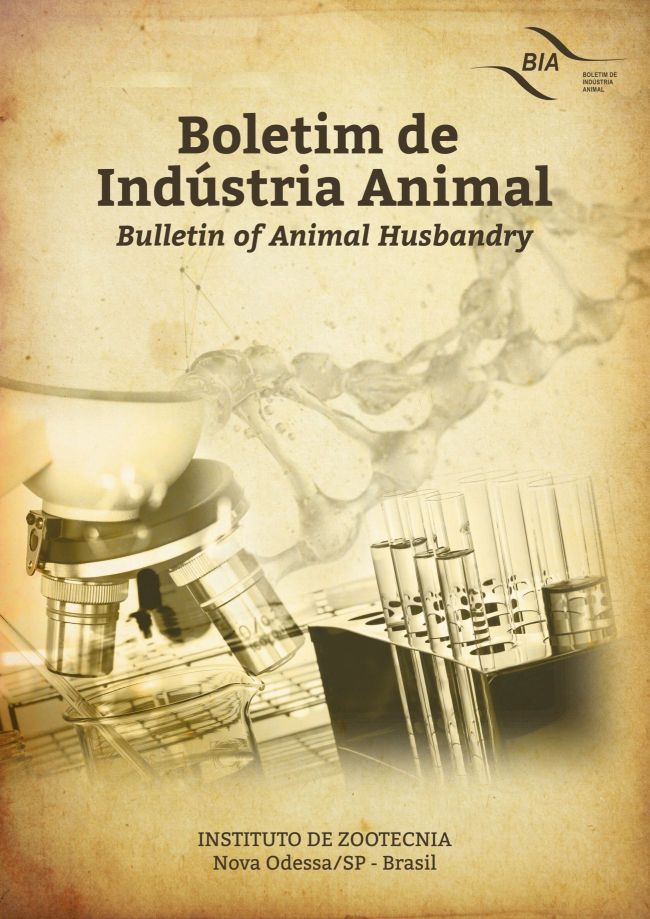Performance and carcass characteristics of immunocastrated, surgically castrated and non-castrated cattle
DOI:
https://doi.org/10.17523/bia.2023.v80.e1512Keywords:
Sexual dimorphism, Fattening, Subcutaneous fat thickness, Weight gain, Finishing gradeAbstract
The objective was to evaluate the performance and carcass characteristics of immunocastrated cattle, compared to castrated and non-castrated cattle, supplemented in pasture. Thirty-six cattle were used, distributed in an entirely randomized design, in three treatments: non-castrated animals (ANC), animals castrated later by surgical method (ACC) and immunocastrated animals (AIC), with 12 repetitions each. The immunocastration was performed following the protocol of two doses of the immunocastration vaccine, with an interval of 60 days, promoting a castration effect of 120 days. The animals were kept in mixed pasture in a rotational system, receiving high performance mineral supplementation in the first 3 months and specific feed for the fattening season in the following 3 months, following the standard of the property. The total experimental period was 180 days. The data were submitted to normality test, variance analysis, and comparison of means by Tukey's test at 5%. The average daily weight and total weight gains, hot and cold carcass weights and hot and cold carcass yields did not show statistical differences (P>0.05) for animals submitted to different treatments. However, the cooling loss was lower in immunocastrated animals (P<0.05), followed by surgically castrated and non-castrated animals. Immunocastrated and surgically castrated animals had higher carcass finish (P<0.05) than uncastrated animals. The initial carcass temperature was lower (P<0.05) in the immunocastrated group but the final temperature did not present statistical differences (P>0.05) for animals submitted to different treatments. The final pH of the carcass was higher (P<0.05) in immunocastrated animals than in the surgically castrated ones, but did not differ (P>0.05) from the non-castrated ones. Immunocastrated animals, in a pasture system receiving supplementation, presented similar weight and carcass weight gains compared to non-castrated and surgically castrated animals, however, with lower carcass cooling losses.
Downloads
References
ALVES, L. G. C.; FERNANDES, A. R.M.; SOUZA, G. M.; CUNHA, C. M.; FOPPA, L. Bem-estar e manejo pré-abate e suas influências sobre a qualidade de carne e carcaça de bovinos de corte. Enciclopédia biosfera, Centro Científico Conhecer, v.16, n. 29, 2019. https://doi.org/10.18677/EnciBio_2019A200
AMATAYAKUL-CHANTLER, S.; HOE, F.; JACKSON, J. A.; ROCA, R. O.; STEGNER, J. E.; KING, V.; HOWARD, R.; LOPEZ, E.; WALKER, J. Effects on performance and carcass and meat quality attributes following immunocastration with the gonadotropin releasing factor vaccine Bopriva or surgical castration of Bos indicus bulls raised on pasture in Brazil. Meat Science, v. 95, n. 1, p. 78-84, 2013. http://doi.org/10.1016/j.meatsci.2013.04.008
ANDREO, N.; BRIDI, A. M.; SOARES, A. L.; PROHMANN, P. E. F.; PERES, L. M.; TARSITANO, M. A.; GIANGARELI, B. L.; TAKABAYASHI, A. A. Fatty acid profile of beef from immunocastrated (BOPRIVA®) Nellore bulls. Meat Science, v. 117, p.12-17, 2016. https://doi.org/10.1016/j.meatsci.2016.02.029
ANDREO, N.; BRIDI, A. M.; TARSITANO, M. A.; PERES, L. M.; BARBON, A. P. A. C.; ANDRADE, E. L.; PROHMANN, P. E. F. Influência da imunocastração (Bopriva®) no ganho de peso, características de carcaça e qualidade da carne de bovinos Nelore. Semina Ciências Agrárias, Londrina, v. 34, n. 6, p. 4121-4132, 2013. http://doi.org/10.5433/1679-0359.2013v34n6Supl2p4121
Downloads
Published
Issue
Section
License
Copyright (c) 2023 Bulletin of Animal Husbandry

This work is licensed under a Creative Commons Attribution-NonCommercial-NoDerivatives 4.0 International License.
Os autores não serão remunerados pela publicação de trabalhos, pois devem abrir mão de seus direitos autorais em favor deste periódico. Por outro lado, os autores ficam autorizados a publicar seus artigos, simultaneamente, em repositórios da instituição de sua origem, desde que citada a fonte da publicação original seja Boletim de Indústria Animal. A revista se reserva o direito de efetuar, nos originais, alterações de ordem normativa, ortográfica e gramatical, com vistas a manter o padrão culto da língua e a credibilidade do veículo. Respeitará, no entanto, o estilo de escrever dos autores. Alterações, correções ou sugestões de ordem conceitual serão encaminhadas aos autores, quando necessário. Nesses casos, os artigos, depois de adequados, deverão ser submetidos a nova apreciação. As opiniões emitidas pelos autores dos artigos são de sua exclusiva responsabilidade. Todo o conteúdo deste periódico, exceto onde está identificado, está licenciado sob a Licença Creative Commons Attribution (CC-BY-NC). A condição BY implica que os licenciados podem copiar, distribuir, exibir e executar a obra e fazer trabalhos derivados com base em que só se dão o autor ou licenciante os créditos na forma especificada por estes. A cláusula NC significa que os licenciados podem copiar, distribuir, exibir e executar a obra e fazer trabalhos derivados com base apenas para fins não comerciais.













